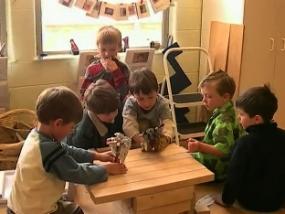Photographs as Plans rather than Records

Six boys meet to rebuild a block structure that was photographed the day before. At two points in this video clip they go to the photograph for guidance. They do not have enough long blocks to finish the roof. At the teacher’s suggestion they look at the photographs and discover that the long blocks were used as the floor and a white tray served as the roof. Michael returns to the block structure to annex it with the white tray. The boys forego the problem of the incomplete roof. On the other occasion, George reminds the group that the action-figures in the photo are on top of the structure rather than inside as they are now. Michael, the leader, counters that the action-figures have to be inside to guard the bed chamber. When the teacher asks for clarification, Robbie explains that the guards can be on top during the night because the bad guys sleep during the day. In other words, the photo represents the day, but the block structure represents the night.
Here we see how a documented plan, in this case the photo, causes the children to provide reasons for their actions, to converse among themselves, to make suggestions and offer counter suggestions. Without the photographs of yesterday’s structure, their block building might not have provoked this more reflective stance of justifying actions, giving motives to decisions and tackling the challenge presented by a limited supply of long blocks. The boys are in essence "reading" the photograph as a set of instructions rather than simply treating it as a recorded memory. They use the details of the photograph to make choices about what to do next. Using a photograph as a plan for action rather than as a memory record requires a mind shift important for self-teaching. On a further note, we should not be too concerned about how well the boys follow the instructions implied by the photograph. These boys are learning how to explain a change in plans. The fact remains, the context for such learning would not occur without some documentation of their plan.
Keywords: Fours, Children-Object, Spatial Relations, Communication, Negotiation, Co-construction
Length of stand alone master video clip: 6 minutes 19 seconds
